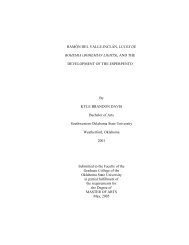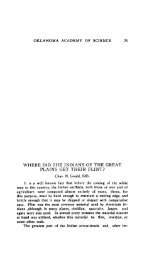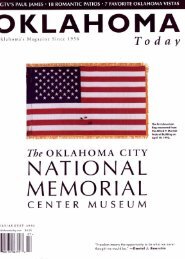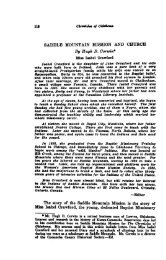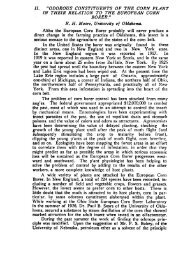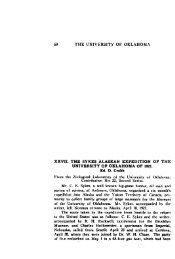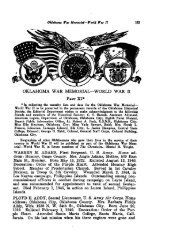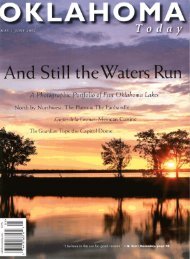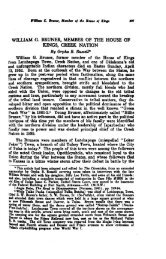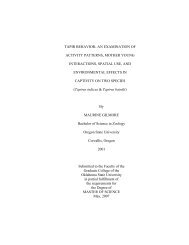You also want an ePaper? Increase the reach of your titles
YUMPU automatically turns print PDFs into web optimized ePapers that Google loves.
TKE; QUIEUTE RI33 OF I."31mS, on its )<br />
om behalf and on behalf of the EOH )<br />
TRIBE OR EXEDS OF IKDIAI.?S; FOH TX33 )<br />
OR BAND OF IICIIXNS, on the relation of )<br />
and represented by SCOTT FIShFi, on )<br />
its -own behalf, 1<br />
1<br />
Petitioners, )<br />
THE UNITED STATZS OF AIBUCA, 1<br />
Defendant. )<br />
Docket k. 155<br />
Decided: December 1, 1958<br />
FINDlllGS O? FACT<br />
The Cadssi.cn makes the following fidings of fact:<br />
1. The Wleuie Tribe of Icdians are an identifiable tribe of<br />
American Indians who resided in aboriginal tines within the terri-<br />
torial *ts<br />
of tne United States in :ihat is ncd a northwestern<br />
portion of the State of Yashington.<br />
xe find the identity of this<br />
aboriginal tribe, as such, has been est25lished in this record and<br />
meets the require=ents of the I.:dian Claim Codssion Act of<br />
August 13, 1946. (50 Stat. 1049; 25 U.S. Code, Sec. 70(a))<br />
EVIDZiL'TIXRy FACTS SUPP0RTI::C- ULTIXT3 FIZDIXG Q? ?ACT 120. I<br />
a. The United S-tztes recc gxizeS this triSe in the preable<br />
of the Trezty with the ~Xnaielt, etc, in 1655 (12 Stat. 971;<br />
I1 Kappier ~ 1 9 sozethes ) ~ called the "?keat;~ of 01~mpia."
. "Hznabook of Anerican Indians, (1912) Bulletin 30, Part<br />
11, edited by Frederick :;'ebb Eodge of Sriithsonian hstitution, states:<br />
tlGuileute. A Chinakuan tribe, now the only representative<br />
of the linguistic stock, :hose aain sezt<br />
is at Lapush, at the mouth of Qillayute r., about<br />
35 mas. of C. Flattery, n, coast of Yashington.<br />
A small division of the tribe, the Hoh, live at the<br />
mouth of the river of the sme name, 15 m.<br />
s. of<br />
hpush . . . . Salmon are caught in considerable<br />
numbers and constituted an hportant ?rticle of food.<br />
Roots and berries of various kinds are also much used,<br />
Although the woods in their vicinity abound with deer,<br />
elk, and bezr, the Quileute sees to have hunted them<br />
but little and have confined theselves to 3 seafarin2<br />
life.<br />
c. The identification of the Guileute Tribe w2s ~ d by e Terri-<br />
torial Governor Isaac I. Ste-:ens,<br />
Superintendent of Indian Affairs,<br />
Iz. Shm~ns, Indian Azent, ?:r. Gibbs, Secretary, I'r. Franli S'nz;~, Inter-<br />
preter and Special Azent, P's.<br />
Tzppan, Sub-azent, together with the en-<br />
ployees of the party, who took part in a council %ith the Upper ar?d<br />
bxer Chehalis, bwer Chinook, Cowlitz and Wnautl Indiam."<br />
This<br />
couhcil bec=e 2 are&inar;); step to the subsequent Treaty at Olyzpia<br />
some months later.<br />
The council, begun in Februaq- 1855, was held "on<br />
the site ol KT. pi14enton1s claim a fex zilas above tha entrance of tks<br />
Chihalis -River into Gray Harbor."<br />
Its journal re~orts:<br />
It was no- ho~revzr found that the Q~inziults did not<br />
Occu?y the whole country ktween the Chihzlis 2nd the<br />
Kakahls, but that ap.other and distinct tribe, the<br />
Kwilleyutes ..qere intgz.efiate. Thi c; was perceivsd uaon<br />
collecting voc&ulzries of the lzn~ua~es for coizparison<br />
that of the K.iriUeyates proving to be entirely dilferent,<br />
and upon pwsuing the inq~rg it was further ascertzined<br />
that the cessewzrs sent u~ the Ccast h2d for this reason<br />
not notified them of the Comcil. Being wholly unrepresented<br />
therefore, they were necessa-ily orLtted in the intended<br />
negotiation but t5eir nu~bers are ascertained to be<br />
about 300.
The necessity of Ethnological inqdry ic conzlu5icg arrangecents<br />
for treati~z with or locatirs Iridians is strikingly<br />
shorn in this instznce'. (pet. Ex. 17)<br />
'here is a renote possibilitj that Horatio Hale, philologist of<br />
the United States Exploring Excedition (1239 - 18&2), in reporting on<br />
the tribes of tZis region m y hzyre made bare nention of these Indians<br />
as the lrKr.;enaiwitl.lt<br />
(aft. ZC, 18, p. 212)<br />
Govercor Stevenst effort in 1854 to take a census of the tribes<br />
and ba~ds oorth of the Chehalis River up to Cape Flattery had been<br />
thwarted by sor:e Indians called ",Zci-eets," ai-5ed viith guns a d knives,<br />
who stopped. Colonel Sh~ons fron crossing. the Qeets River. (pet. 2s.<br />
d. J ~ e G. s Siian published ir: the "b!orth;.iest Coastr1 (1.~57)~ an<br />
account of the ne~otiations at the abovs-mentioned treaty council, re-<br />
porting:<br />
*%it Ylke features and provisions of this treatywere<br />
these: The Indians were to cede all the territory,<br />
coxencing on the Pacific coast, at the divide of the<br />
Q~aitso (~ueets) and Hooch (hoh) Zivers, thence east<br />
betveen the .sane slow the line of the Guill=.h:pte<br />
tribe, to the srdt of the coast range; thence south<br />
" -z. (Underscoring supplied)<br />
e. S~pe~intendent of Indian Affairs, R. H. Filroy, reported on<br />
the ide~tit7 and location of petitio~er Indims in post-treztg times<br />
+ 5 %ut one of the four tribes tkat h~ve been nade<br />
pzrties to the cirinaielt treaty is m the reservation.<br />
The c&iliutes, Hohs, axi Qaits reside at dilferent<br />
points and distznces north of the reservation,<br />
and szy the;^ n2ver agreed to sell their cmntry, nor<br />
did they, to their knowledge, sisn any treat:< disposing<br />
of their rizht to it. Thzt they were presezt at
the tiye of the treaty with the.:: is alleged to hze<br />
been ude, but that the paper that they signed w2s explained<br />
to then to be an a~ree~ent to keep the peace<br />
with citizens of the United States 9 -"-*. They therefore<br />
refuse to leave their ho~es and localities in<br />
which they then and still reside, and move on the<br />
reservation which they (the @iliutes, Hohs, and Quits)<br />
regard as the homes and property of the ainaielts.<br />
(Pet. Ex. 40, pp. 339-3401<br />
f. Eth~ological xorks of the twentieth md late nineteenth<br />
centuries which nention or identify the Quileutes are several. The<br />
only known works which treat specifically xith the Wleute are dis-<br />
cussed by petitioner's anthropolo~ist, Dr. Verne Frederick Rzy.<br />
In<br />
his testir;,on;., Dr. Ray nentions the unpublished field notes of his<br />
fomer student., Richzrd Daugherty, Professor of Anthropolosy at<br />
long-lost nznuscript of Dr.<br />
fee J. Frachtenberg as the earliest works<br />
treating krith G,leute Indians in a>y detail. (R. ?p. 19-20; Pet. ZY.<br />
93, apparently an extract.)<br />
.,<br />
2. ' The Hoh Indians were a small division of the Euilleute Tribe<br />
and resided principally at the ~outh of the Eoh River.<br />
( See Finding<br />
No. 3 belox)<br />
3. Xe find this petitioner is the tribal orgaization of Quileute<br />
Indians tinose predecessors in interest, Quileute 2nd Eoh Indians, ceded<br />
their lzds, together with other grouns of Indians, under the term<br />
of the Treaty with the ,Quinaielt, etc., to defendmt. (12 Stat. 971;
7-Ind. C1. Con. 31<br />
separzte and distinct from the dialects of their Sdishan spea!cirg<br />
neighbars. (see Eridentiary Findings lb and lc. )<br />
b. In 1877, Dr. George Gibbs nade a compre3ensive report<br />
for the Sziithsonian Institute on Washington Indim in which he<br />
described the Quileute Indims as follows: (Pet. Ik. 20; Dft. Ex. 4)<br />
" * *There are two bands of this tribe, the Xirillathuit,<br />
of Kive-dee-tut, and the Huch, of &-raat-sat .<br />
(P. 165)<br />
c. In abed 1907, Albert B. Reagan wrote =The Hoh and Quileute<br />
Indiens, Archaeological Rot~s.~ Reagan located the Quileutes at J=es<br />
Island and at the muth of the Quilayute River. (pet. Xx. 78)<br />
d. In 1920, Leo J. Frachtenberg published the nEschatology<br />
of the Quileute Iniiar~.~ (Pet. Ex. 86) Frachta5erg nost eqhatic-<br />
ally rejected thenEoh" as beip-5 a separsfe tribe a d defined then as<br />
merely a gzogrzphic location of Quileute indians. He reported :<br />
* + *%rlier k-riters and particulzrly Farrand, assigned<br />
three distinct dialects to this group; the hinzkm, the<br />
Quileute, and the Hoh. The latter, hotfever, according to<br />
a detailed in~estigation carried out by the present writer,<br />
shows no articular points of differentiation from the<br />
Quileute<br />
variety, and the word Eoh my be sztely assmed to<br />
be a prely gpographic term " -2 *.<br />
e.<br />
In 1924, Dr. W. C. Flckod pyblished *The Origin of the<br />
State" in ~hich he reported (~ft. k. u3, pp. 31-32):<br />
* * 513 the grezt Fxget Sosd area occxpied zhost<br />
wholly by Salish-speaking tribes, there exists the<br />
oriLyh.;o grouy, both very s~all independent political<br />
ILQ~S, representing an inde~endent linzdst-ic<br />
n<br />
stock - The Ck~km. Ine gaps are the C;?;ileute<br />
and the Chinzk-m Tribes, xhich, when aiscove.red by<br />
the tihites tiere poss~ssed of a precarious hdd of<br />
two separated portions of the shore oZ the Sollnd<br />
and a'; Mar cozstantl;~ vith their SalLsh nei&bors<br />
a d the b:akz\ Iioot!
f . Janes l!ocney I s population statistics, published in 1928,<br />
explain the decimation of the Indians of this area in pre-treaty times<br />
as folbws:<br />
(Pet. a. 85, pp. U-16)<br />
-2 X. * That regular trade of ocean vessels at the mouth<br />
of Columbia 1788 mzrked the introduction of sexual diseases<br />
from sailors and traders which soon poisoned the<br />
blood of practically all of the indians west 02 the Cascades+<br />
* *. Liq~or, introduced in large 2uantities by<br />
Russian traders, despite the efforts of the Hudson Bay<br />
Company officers to prevent it, is also said to be a po-<br />
tent destroyer along the coast ad the Colmbian (~arnham)<br />
In 1823-2 * *an epidaic of fever':- * *spread* 3 and<br />
zpparently also along the coast and central region* x- +.<br />
It destroyed four-fifths of the natives, practically exberminating<br />
the Chinookan tribes =- -> %but the SalishanG 3 5<br />
tribes of Wxshlngton appear to have escaped, In 1846 the<br />
Colmbia tribes +x- -Z suffered another visitation of srcallpox,<br />
In 1847 a measles epidedc spread" 5 *. In 1852-3 smallpox,<br />
introduced from San Francisco anong the 1.kkd-1, with<br />
its usud destructive effect aizong nearly all the tribes of<br />
Washicgtons + +wiped out whole villages in soce tribes.<br />
Washinqton, Xestern Tribes<br />
Yakah ( Quinne chant )<br />
Quilleute and Hoh<br />
Q-cinzielt and Gueets<br />
g.<br />
The Quileute tribe of Indians of the Quileute Indian Reserv-<br />
ation were incorporated and its charter ratified on August 21, 1937.<br />
The Constitation and By-Lars of said tribe were approvet! 5y the Secre-<br />
t?zy of the Interior on Hovenber 11, 1937, pursuant<br />
to Section 17 of<br />
the ;.?.eeler Xoward Act of Junz 1G, 1934, 48 Stat. 984. hecods, De?t-<br />
. . . .-<br />
Of the Interior, Burezu of Indian Af f a*~. )<br />
4. The political orgmization of the Wieute Tribe was ul inte-<br />
gral p~-t of its social order.<br />
T'nis social orgzri=tion was coiidnated<br />
by the concept of class consciousness found throughout the Fkqet Somd
areas in which each kdividul w2s born into his place, as a slave,<br />
corioner, or of the royalty or "chiefn class.<br />
rank,ing nenber of<br />
this socizl structure was a "lerdern or respected "chief<br />
of the vil-<br />
lage. fk ;;as spokesrsn for the village in tribal natters. (~estinon~<br />
of Dr. Ray, 1 Tr. 63-64)<br />
5. Petitioner rs aboriginal territory w2s located along and inland<br />
from the Pacific Cost in the present Stateof tiaskington betxeen Gray's<br />
kbor and the Strait of Juan de Fuca.<br />
Tkt area had no natural har-<br />
bors and was so heavily wooded that it was extrezely difficult to<br />
traverse by ltnd.<br />
Aboriginal conditions of the Quileute Tribe were<br />
undisturbed at the t5e of treaty nc~otlations with the United States<br />
in 1855, and rern2i~eci relati-zely unciisturbed as late as the latter<br />
decades of the nineteenth century.<br />
(~r. Lurie's Testii~ony, 2 Tr.<br />
pp. 282-283)<br />
6. During F e b m , 1855, Governor Isaac I. Stevens scheduled a<br />
treaty council invol*ng<br />
I~dian tribes wes* of the Cascacie Kauntzins<br />
whose lad had not theretofcre been ceded.<br />
He smoned representatives<br />
of allsuch tribes kmxn to hiL? except the Upper Chinook zc6 klikztat<br />
Indians. That SXDOES included the Quinaielt, Upper Chehalis, Lower<br />
Chehalis, Lower Chinook and Cowlitz Tribes.<br />
'Ece Council w3s held a<br />
few n5les north of tte entrance into Grap's B=Sor.<br />
Not until the<br />
-<br />
beginnix of this co-mcil did off icials of the Unitad States discover<br />
there was a Quileute tribe md that it occnpied territory between the<br />
Quinzielt and IGkah tribes. After this discover:;, Cavernor Steve:.::<br />
did not suznon Quilezte<br />
representatives to the courLcil but procesrl~'
7-Ind, C1. Corn. 31 38<br />
to present to thegmups present a draft of a treaty for consideration<br />
and adoption,<br />
He was unable to obtain agreezezt to its terzs.<br />
..<br />
7. lhe uTreaty of Olppia," as it is co~etimes called, was con-<br />
summated after the Feb vuary-X-larch 1855 Trezty Council took place.<br />
Governor Stevecs hid instructed Colonel K. T. Sirmons to explore the<br />
territory Setxeen that occupied by the Yakah Tribe and gray's Earbor.<br />
(pet. Ec. a) Xhile carrying out this exploration, Colonel Sioxons<br />
met with the Quileute and Quinaielt tribes on their home pounds and<br />
concluded a treaty which Governor Stevens subsequently signed at Olympia,<br />
3<br />
Bashington Ter~itorr.<br />
The different tribes and bands of the Quineielt and "Quillehutel'<br />
Indians ceded ell their rightsin lands occupied by the=, bounded and<br />
described in sdci trenty as follows:<br />
'<br />
* * Xamencing at a point on the Pacific coast,<br />
which is the southwest corner of the lards lat-ly<br />
ceded by the &kah tribe of Indians to the United<br />
Stztes, and runnicg easterly with and dong the<br />
southern boundary of the said ?kkz!h Tribe to the<br />
niddle of the coast rznge of aouiitiins; thence<br />
southerly with said range of nountains to their<br />
intersection with the dividing ridge beheen the<br />
Chehelis and Quiniztl Ftivers ; thence wssterly with<br />
said ridge to the Pacific coast; thence northerly<br />
along szid coast to the place of Seginning. (Treaty<br />
with kinaielt, etc., 1855, l2 Stat. 791, I1 Kapp. 712)<br />
8. The treaty further provided, "in consideration of the ebove<br />
*<br />
cession the United Stztes azree to Fay to the said tribes =d<br />
bands the<br />
3um of twenty-f ive thousand dollars+ * 3, (.Article 4). Article 5 further<br />
-<br />
provided "Ti:e United States further agee to F-J the s:m of three thousa~d
In 1861, a reserration on the Pacific Coast south of the mnaielt<br />
River vas established. by the Su~erintendent of Indian Affairs for<br />
Washington Territory for the Gllinzlelt and Quileute Tribes. Subsequently,<br />
in 1873, thqt reservation was enlarged to its present size<br />
byhecutive Order, aca was opened to other tribes of "fish-eating<br />
Indiansff on the Pacific Cozst. (pet. Ex. 41;) The Wleutes, in 1889,<br />
were set aside a snaU reservztion by President Cfevela~d at the nouth<br />
of the Quillayute River (pet. Ex. 46). In 1693, a srnzll reservation<br />
was set aside zt the mouth of the Hoh River for the Hoh Indias.<br />
(Pet.<br />
Lu. 61)<br />
9, The Quileute villagcs were situated about the nouth of the<br />
Quillayute her, on Jznos Island, xith cm?sites along the Quillzpte,<br />
Dicke:~, Sol educlc and 3ogachiel Fivers in aboriginil times.<br />
Si~ilsrly,<br />
the villzges of Hoh fndians were situated at the mouth of the Hoh River.<br />
Tenporzry or seasond caps were maintained by these Indians near their<br />
fish-traps along the respective rivers bezring their n-mes. The lo-<br />
=. 73)<br />
cationsof these caqsites and villages are shmm on Dr. Rzyls rap,<br />
(~lkf.<br />
Dr. Lo J. Frachtenborg's manuscript, found by Dr. Verne Frecizr-ti<br />
Ray in the hericzn P?ilosopnlcal Society's Library in Philadelphia<br />
(R,, p. 20), includes a historical account of the Quileute, dated 1915,<br />
-<br />
bg Arthur Roxeattfe (pet. 2. 93, Q. 2:1), who was the son of the<br />
last Chief Hoxeattle of the bileutes. The last chief died in 1898.<br />
The uncle of this last chief >;as the old Chief 3oweattle who ps-: ' -<br />
pated in the treaty cession of the Wleute vith C-overnor Stevens.
'This ini'ocer reported a long series of %rzrsn with the aggressive<br />
fdakah tribe lastir! until "just prior to treaty tb.esl'.<br />
Durirg the<br />
period of these %-rarsn the qrileute noved to J=es Islznd, a natural<br />
fortress, accessible by only t ~ trzils o he?m by the Quileutes<br />
through<br />
rock passages situate5 at the mouth of the Quihyute River, Just<br />
prior to the trezty, the Quileute noved back to kpush which was their<br />
only pemanmt village.<br />
From this one per~anent village, the Quileutes<br />
established seasonal camps dong the Quillapte River and near its con-<br />
fluence with its major tri5utary rivers.<br />
Quileute hunting parties<br />
occasionally tient as far as the snow ridges of the Olppics on the east<br />
for deer, bear a d elk.<br />
'ko notable errors seea to appear in the re~rts<br />
of this in,'orzer,<br />
nanely, that the Hohs were only recent additions to<br />
the Quileute, being origbdy of the Quinaielt tribe, and the map of<br />
Quileute locations showstbe ~outh of the Dickey River f1o:iing hto the<br />
Pacific rather thm into the Quillayute River.<br />
Howezttle also .stzted<br />
"the Wleute thought they had ceded the north half of Izke Ozetten,<br />
he further related how, about 70 years earlier (about l8.46?), Wleutes<br />
learned fw-seal-<br />
when Chief Howeattle vent Ison a visit to the<br />
Ozettes, and under tY,raveln, (QL., 3 :I31 of Pet. Ex, 93), Howeattle in-<br />
forrris "few 03 the k"uiliutes ever tried or had a chance to lezrn the la=-<br />
Xuage of the lhk~hs (S;)OIC~E 53 the ~zettes) and Qcinaults. " " -2 >- - The<br />
greatest zzount of travel was done between Hoh a~d Lzpush-: %-<br />
-> *since<br />
both tribes were rzlated (sic) there tizs a great de~l of-friendly visit-<br />
in?, at aU seasons. "<br />
10. Ozztte Lake area :Tas not exclusively used ard occupied by the<br />
(bilcute Indians,
a, D-e I-iakh Tribe (Docket 120. 60) assert cl2-k to the laid<br />
areas northeast of the Quileute TriSe.<br />
T5ere is an overlap of a~pox-<br />
bztely ten iailes wide of the respective claim of this petitionzr<br />
and the &kzh Tribe,<br />
The Elakah clzi? the southeast cQrner of their<br />
aSoriginzl lands was located at Cape Johnson ~ hich is appro~~m.ateljy<br />
four niles north of the Cuillayute River.<br />
(Dkt. 60, Far. 111, Oriz.<br />
Pet.)<br />
b. The petitioner, Quileute Tribe of Indians, dispte this<br />
and claim the nmtheast corner of Cuileute aborigical lands was at<br />
a point approxh2tely six d les sonth of the mouth of the Ozette<br />
River. Tfius, zn overlap of claim of the petitioner tribe =d th2<br />
hk2h Tribe is described c~~aining a strip of land appro~Lmtel7<br />
ten miles in width extsnding along the whole south bounday<br />
of the<br />
territory claiized by the fkkah Tribe in Doc?tet 6G, and such overlap<br />
includes a large portion of Lake Ozetke.<br />
(~'d. 155, par. VII of<br />
A~ended Pet., filed Dec. 23, 1955)<br />
c. Dr. Verne Frederick Ray on behalf of petitioner conducted<br />
2 research of the zrez in q~esticn (pet. Ex, 125) and his conclu-<br />
sions seen to agree slrSstzntially, if r,ot absolutely, with the cession<br />
bow-dq described in the treeties above nentiored. (5 Tr. pp. 733-'73i;) .<br />
Both Dr. 2q and the trezties of cession see3 to suaprt petition?rsl<br />
allegztiom so fa as the location of cession 5o~~dar-y betxeen the<br />
Mak*<br />
a d the Gdle~te is concerned.<br />
?wever, ~-otxiths tanding these<br />
considerations of tr?e locrtdcr, of tke comon 3i3=&~y as it 1.2.~ de-<br />
scrijed in the trszty cession involved zni the rather thorough re-<br />
sesrch ol' Dr. by iziterpreting sze, :.:e fld thzt Ozette hke, and
necessarily the shoreline surrounding it, was not used and occupied<br />
e x lusively bz the Quileute Indians.<br />
d. Governor Stevens was not well informed on the aboriginal<br />
boundaries of the Indians, Quileute<br />
and bhkzh, in the Ozette Lake<br />
area, in fact a hiatus in the reports of "Indians west of the Cascades<br />
and north of Gra;rs Harbor" existed in the journals and maps of government<br />
men zzd explorers until long after treaty tines as to any<br />
exact location of the north aboriqinal boundal-y of the Quileutes.<br />
Gover~or Stevensf investigztor, Specizl Agent Shons, was<br />
forcibly prevexted by "about 50 &i-eet<br />
Indiansu from crossing the<br />
Queets Eier north:rard into Hoh and kileute territory to investi-<br />
gate the bou&ay in 1854, zs he was instructed to do by Stevens.<br />
(pet. Zc. &)<br />
Goverxmr Stevens' assistant, Dr.<br />
George Gibbs, indicated his<br />
ignorance of tht Quileute, or their territory, in his report dated<br />
Much 1;) 125&, to Captzin Gorge B.<br />
KcClellan, Conmnding Western<br />
Divisior,, PI.<br />
P. bilroad Exploration, 'in,.these words, "Still further<br />
north, 2nd Set-;~een the Kxinzitl a d the Makahs, or Ca~e Flattery<br />
1ndiar.s. arc other t~ibes still uknown, but who by vague rmors<br />
* " *are both nunerous a d warlikeatt At page 429, Ebbs stated,<br />
"The >kk&?s, or Clzssets, inhabit the coast in the neighborhood of<br />
Ca~e Flattl,~, their country extending but a short distulce up the<br />
Straits, wherz it adjoins thst of the Clallaxs.<br />
Their-laneuaqe is<br />
said to e:&erA h~lf xay doxn to Gray s Har5or ." (~nderscoring sup-<br />
plied)
'The rzzps drawn by Stevens in 1857 after treaty times completely<br />
onit Lake Ozette, as does the Survey or General's ZZap of 1865, as<br />
does the $9. H.<br />
Dall (~ibbs) 1,:ap of 10"77, corsistently showir-g the<br />
onission of Iake Ozette until Potrellts Pap in 1891 (see Pet. Ex.<br />
125). Frachtenbergt s later map of &ileute territory (1919) shcxs a<br />
mislabeled "Dickey Rivern (~llen Creek ) as the north Quileute<br />
boundary, six or seven miles south of hke Ozette. (pet. Ek. 125)<br />
Skinonsf and Shz:-rls trip dovm the coast from Cape Flattery in<br />
1855 was z renexed effort to supply Governor Stevens with boundary<br />
infomation, but app=ently was not a thorough recmmissance,<br />
which is 03-~ous upon notirg the omission of hke Ozette froa the<br />
maps of t3is area for so aany years after the treakpcession.<br />
e, Neither the "Peaty of Ol~pia', 12 Stat. 971, 11<br />
Kappler 77,9, nor the "Treaty of Neah 3agn, 12 Stat. 939, I1 Kappler<br />
682, with the ?:A\& Indians, described the comon boundary line on<br />
the gound between the 2"aka.h and Wlleute Indians, further than the<br />
location of the afore-nentioned comon'corner of such bounsary.<br />
This corEr, in the Treaty of Me& Bay, azd referred to in the<br />
Treaty of OQiqLa, is described in the forzer as nmJling south-<br />
~2rdl7 aorg the coast to Osett, or the Lower Cqe Flztte-?;<br />
thence east~ardly along the line of lands occuaied 54- the Kxe-deh-tut<br />
, . -<br />
is z~bi~ous because there is a lake, river, islmd and village all<br />
naed Osstt; but probably the villagz wzs the reference point intecded<br />
by "Gsetttt since it constitutes a point ncst readily ciscer~ible
at "Lower Cape Flatteryn. Evidence extreneous of the language of<br />
the respective treaties must be relied upon to establish what was<br />
the "lipe of lands occupied by the Kwill-eh-yute tribe."<br />
f. Dr. Roland L Olson in his "The Cuinault Indiansn (1936)<br />
in.classifying the Indians in this area wrote:<br />
-2 * * * The Ozette, who lived about the lake of that<br />
name and zdjacent coast, and the Suez (Tsuers?) who<br />
lived along the Suez River, where Xkkah groups but<br />
probably regarded themselves as distinct tribes,<br />
g. The Ozette were an internediate group of Indians situat-<br />
ed between the Kakah proper and the petitioner.<br />
The Ozette village,<br />
in pre-treaty tires as now, is more centrally located to this dis-<br />
puted overlap area than either the MWk& proper or this petitioner.<br />
we<br />
fl~d InsMflclent euldence in this rescrd to zssocizte the<br />
Ozettes as part of the Quileute tribe.<br />
h. The docuztentary evidence of this overlap area in treaty<br />
tkes was indeed vague and scant. Dr. George Gibbs commented in<br />
his "North American Ethnologyn (l877), thereon as follows : (pet.<br />
Ex. 20, p. 166)<br />
-x- * * *hiorth of this (country of the Chehalis) there<br />
were no lznd-locked hzrjors, the st~ezss entering tine<br />
sea directly and without estuaries; of these there are<br />
several, the lawgest beiw the K-~inaiutl, the Loh-whilse ,<br />
and the Kxillehict. !bet is known of this section is<br />
chiefly fro2 the ,joa-3e;r of tIessrs. Shons and Shaw, who<br />
followed the coast covn fron Cape Flattery, in the swer<br />
of 1855.<br />
11. The whole of the 0l;mpic zountain range was a free range<br />
-<br />
to everyone. (~unther's Klalla Ethnography, p. 205) Dr. Ronald<br />
Olson in his study, "The Quinault Indizns" (1936) reports (Pet. Ec.
7-Ind. C1. Corn. 31<br />
* " * Werritory. In theory the triSal territory<br />
embraced the whole region drained by the Guinarrlt<br />
river** *. In practice not a foot of tribalterritory<br />
was sharply determined. The southern boundary<br />
is said to have followedit * * to the sudt of the<br />
Olympic mountains. The heights above the sources of<br />
the river were more or less common hunting territory<br />
for Quinault, Skokozish, Klallan, and @eets. The<br />
northern 1h.it of Quinault countq was roughly along<br />
the northern rim of the watershed to the somce of<br />
the 2aft river and down that strem to 3s mouth.<br />
12. In aboriginal tines the Quileute Indians very largely<br />
subsisted on fish and sea300d.<br />
They utilized fishing weirs wnere<br />
saloon were caught along the Quillayute<br />
River. &ilecte Indians also<br />
fished on the Bogachiel, Calawah znd Soleduck rivers. (R. 295-296)<br />
Along the adjzcent Pacific coast Quile~te caught sineft, bass, pug,^,<br />
~ ~ ~ , >-Z\Z=~=<br />
~ , ??4, ~ ~ ~ g - ~ ~ ~ ~ , ~ ~ $ ~ =<br />
fish shark, herring sardines, stmgeons, seal, sea-lion,porpoise<br />
and whale.<br />
(pet. Ex. 93, P. 3: 57) The Hoh lndians fished along<br />
the river bearing their me.<br />
These Indians, Quileute<br />
and Hoh, also hunted deer, elk, small<br />
game and birds (Fet. Ex. 74), including grouse, pneasult, wild<br />
geese, cnck, brant, white-crested corn-orant, fa1 m, sea-gull,<br />
puffin, rhinocsros auclid and loon.<br />
(Pet. Ex. 93, p. 3 :l8)<br />
On Little, 9uillapte, kcfield and Forks Prairies near the<br />
afore-zentioned fishing streax, ucon which they travelled by canoe,<br />
were gzthered goosebexies, red and blue huckleberries, sakon,<br />
-<br />
elder, salal, SlzckSerriss. thbble berries and strzxberries by<br />
these Lydiazs. They dug cazs znd white clover roots at Forks a~d<br />
other prairies.<br />
-<br />
(?et. LY. pa. 3:27 2mi 131)
7-I&. C1. Sox. 31<br />
13. The 2uileute Tribe of Indizcs, together with their sub-<br />
tribe of Hoh Indians, used a d occupied an area of land in abori-<br />
ginal times described as follows:<br />
* * %omnencing at a point on the Pacific coast immediately<br />
west of the ridge line, wnich ridge is nearest<br />
the mouth of and immediately north of the Quillayute<br />
River, thence northeastward along said ridge line to a<br />
point west of the nouth of Larger Creek on the Dickey<br />
River; thence east across Franklin and Colenvl Creeks<br />
to the ridge line on the north side of the Soleduck River<br />
and following said reidge line northeastwzrd to the peak<br />
on Gunderson Hill; thence to the confluence of PKdield<br />
Creek and Shuwah Creek; thence southwzrd along the base<br />
of the Calmah Ridge to a point on the Calawah River opposite<br />
the nouth of Elk Creek; thecce gecerally southward<br />
along ELk Creek to the southeast corner of Forks Prairie<br />
on said creek-line; thence following along tho, line of the<br />
south bou~dary of Forks Prairie extended to the Bogachiel<br />
River; tkence follo:.riw upstreu;: along the course of said<br />
river to a point opposite the mouth of Dorians Creek; thence<br />
southwxd up Dowans Cresk tn its h~r&rf.~rc zt +_kt? ;cFT~+, cf<br />
Haling Brothers Snin~le Zill; thence south~t7:nrd to the<br />
nearest point in the reverse bend on the north bank of the<br />
Hoh River; thence across the Hoh River southwest.;:zrd to the<br />
nouth of stemboat Creek on the Pacific Coast; thence north<br />
westward alorg the shoreline of the Pacific coast and including<br />
Jrnes Islznd, to the place of beginring.<br />
EXfIDEIfi'IARY FACTS SUPPOZFIXG ULXF4'I'E FIXIIh'G OF FACT NO. 13<br />
a, The north aboriginal boundary line of the Quileute began<br />
on the north side of the nouth of their principal fishing strea,<br />
theQuillapte aver, on the Pacific Coast and south of Cape Johnson<br />
claimed by the lkkah Tribe in Docket No, 60 (?inding 10)<br />
b. This north boundary enco~passed Little Prairie, Quillayute<br />
Prairie, the lower portior, of Dickey River, northeastxard along the<br />
valley drainage of the Soleduck River to include 1-kcfield Przirie.<br />
North of the f:x-ield Prairie was used ~FJ S'Klallzs and other seasonal<br />
users of Lake Plezs~zt. (S1iClalla.z Indiixs, Docket Wo. 134)
c, The east boundayy of the Cuilacte exkecded to the Cala~ah<br />
Flidge of the Olppic Xznge indi ding Xo. 11) encozpassirg Forks<br />
Prairie and up the 2ogachiel River along the ridge line to the Hoh<br />
Valley. (Ending 12)<br />
-I -The south boundary follom the principal drainage area of<br />
the south side of the Hoh River to the Pacific Ocean, the latter<br />
forns the west bouciarg of the &leutc territory. Tne drainage of<br />
Cleawater Creek enptics into the Queets River claimed by the Queets<br />
Indians in the Qinault case, Docket KO. 242.<br />
e. The Quileutes' ancestral land boundaries, as above defined,<br />
include the principal drzinage arzzs of the Wllapte and<br />
Hoh rivers md those aSove nmed prziries.coctigxous to their<br />
fishing sites.<br />
Thei~ lands were genera-<br />
bounded on the north by<br />
the hezvily forested upland regions south of kke Ozette, on the east<br />
by the 01p?ic 1-bmtain Range, on the south bg the Queets River drain<br />
age zrea,<br />
and on the west by the Pzcific Ocezn.<br />
a, Tne lands described in Ficding 13 were -,art of the lads<br />
ceded to the Unoted States by the terns of the Treaty of Olyiiipia by<br />
the diff =rent tribes and bafids of the Quinaielt and Guilleute Indizns.<br />
m.e treaty was signed by dl pzrties between July 1, 1855,<br />
and Janury 25, 1856. This treaty was not ratified, however, until<br />
nore thvl three yezrs lzter or! ?
7 Ind. C1. Con. 31 48<br />
15. Any rightthich petitioner or its ancestors and predeces-<br />
sors in interest nay heve retained or acquired to any land tiithin<br />
the boundaries as set forth in Finding 13 may be made the subject<br />
of inquiry at the further he~ring of this claim respecting the<br />
credits of defendant and consideration paid to peitioner or its<br />
ancestors and predecessors in interest, and as to the value of<br />
said lands as of the effective date of the treaty, fkrch 8, 1859.<br />
Edgar E. Yitt<br />
chief Co-missioner<br />
huis J. 0 fbIerr<br />
Associate Comissioner<br />
Wm. $$.<br />
Holt<br />
Associate Co~xnissioner



